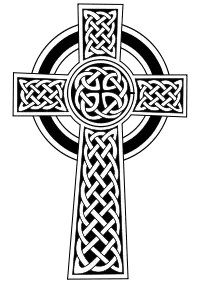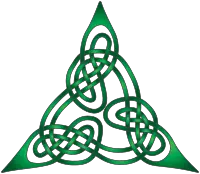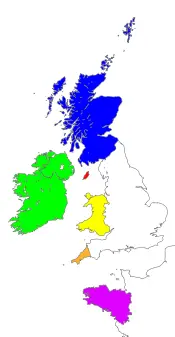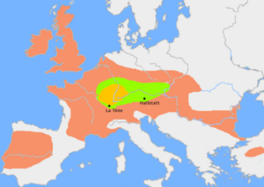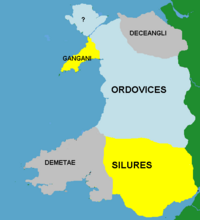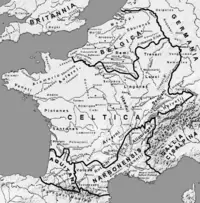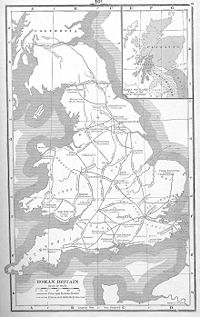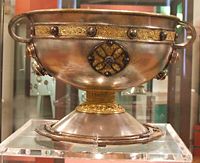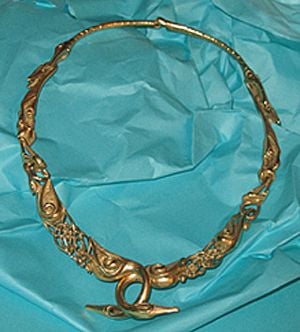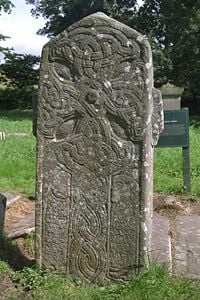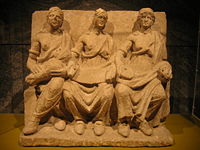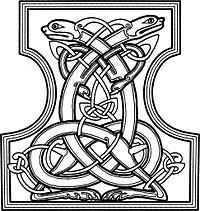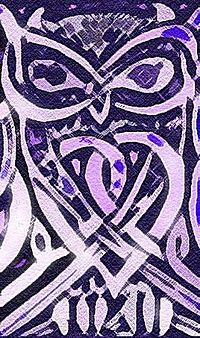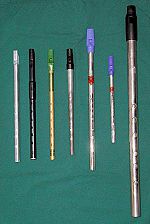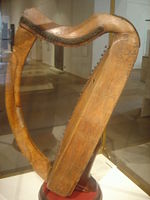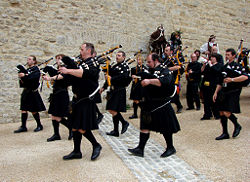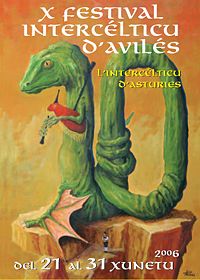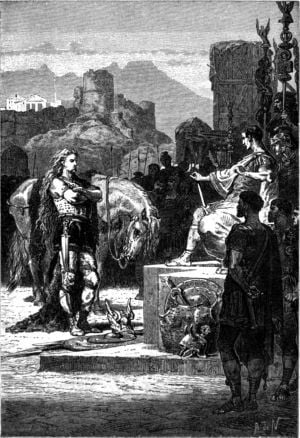The term Celt, normally pronounced /kɛlt/ now refers primarily to a member of any of a number of peoples in Europe using the Celtic languages, which form a branch of the Indo-European languages. It can refer in a wider sense to a user of Celtic culture. However, in ancient times the term "Celt" was used either to refer generally to barbarians in north-western Europe or to specific groups of tribes in the Iberian Peninsula and Gaul.
Although today restricted to the Atlantic coast of Western Europe, the so-called "Celtic fringe," Celtic languages were once predominant over much of Europe, from Ireland and the Iberian Peninsula in the west to northern Italy and Serbia in the east. Archaeological and historical sources show that at their maximum extent in the third century B.C.E., Celtic peoples were also present in areas of Eastern Europe and Asia Minor.
Little is known about their lifestyle due to the numerous conflicts and combinations of cultures that occurred in European history, culminating in loss of power by the Celts even in areas where their language and traditions survive to some extent to this day. Nevertheless, a revival of interest in Celtic culture, including religion, art, music, and language beginning the eighteenth century and blossoming in the latter part of the twentieth century has ignited recognition around the world for the positive contributions this culture makes to modern civilization.
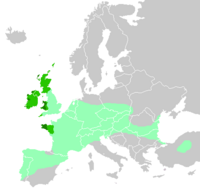
██ present-day Celtic-speaking areas ██ other parts of the six most commonly recognized 'Celtic nations' and where a Celtic language is spoken but not the dominating language ██ other parts of Europe once peopled by Celts; modern-day inhabitants of many of these areas often claim a Celtic heritage and/or culture
History
The term Celt
The term Celt has been adopted as a label of self-identity for a variety of peoples at different times. However, it does not seem to have been used to refer to Celtic language speakers as a whole before the eighteenth century.
In a historical context, the terms "Celt" and "Celtic" have been used in several senses: they can denote peoples speaking Celtic languages; the peoples of prehistoric and early historic Europe who shared common cultural traits which are thought to have originated in the Hallstatt and La Tène cultures; or the peoples known to the Greeks as Keltoi, to the Romans as Celtae, and to either by cognate terms such as Gallae or Galatae. The extent to which each of these meanings refers to the same group of people is a matter of debate.
In a modern context, the term "Celt" or "Celtic" can be used to denote areas where Celtic languages are spoken—this is the criterion employed by the Celtic League and the Celtic Congress. In this sense, there are six modern "nations" that can be defined as Celtic: Brittany, Cornwall, Ireland, the Isle of Man, Scotland, and Wales. Only four, Wales, Scotland, Ireland, and Brittany have native speakers of Celtic languages and in none of them is it the language of the majority. However, all six have significant traces of a Celtic language in personal and place names, and in culture and traditions.
Traditionally, scholars have placed the Celtic homeland in what is now southern Germany and Austria, associating the earliest Celtic peoples with the Hallstatt culture. However, modern linguistic studies seem to point to a north Balkan origin. The expansion of the Roman Empire from the south and expansion of the Germanic tribes from the north and east led to the end of Celtic culture on the European mainland where Brittany alone maintained its Celtic language and identity, probably due to later immigrants from the British Isles.
Some people in Galicia, Asturias, and Cantabria, in north-western Spain, and Entre Douro e Minho, Trás-os-Montes e Alto Douro in Northern Portugal wish to be considered Celtic because of the strong Celtic cultural identity and acknowledgment of their Celtic past.
Genetic evidence of origin
The Y-chromosomes of populations of the Atlantic Celtic countries have been found in several studies to belong primarily to haplogroup R1b, which implies that they are descendants of the first people to migrate into north-western Europe after the last major ice age. According to the studies of European haplogroups, around half of the male population of that portion of Eurasia is a descendant of the R1b haplogroup (subgroup of Central Asian haplogroup K). Haplotype R1b exceeds 90 percent of Y-chromosomes in parts of Wales, Ireland, Portugal and Spain.[1]
Two published books - The Blood of the Isles by Bryan Sykes and The Origins of the British: a Genetic Detective Story by Stephen Oppenheimer - based upon genetic studies, show that the majority of Britons have ancestors from the Iberian Peninsula, as a result of a series of migrations that took place during the Mesolithic and, to a lesser extent, the Neolithic eras. Genetic studies have confirmed people in areas traditionally known as Celtic, such as Ireland, Wales, Scotland, Brittany, and Cornwall, to have strong links with each other. However, they also found that the Irish and Scots have as much, if not more, in common with the people of north-western Spain, suggesting the possibility that Celtic migrants moved from the Iberian peninsula to Ireland as far back as 6,000 years ago up until 3,000 years ago.[2]
Archaeological evidence
The only direct archaeological evidence for Celtic speaking peoples comes from coins and inscriptions. It has been assumed that the Hallstatt (c. 1200-475 B.C.E.) and La Tene (c. 500-50 B.C.E.) cultures are associated with the Celts. Only in the final phase of La Tene are coins found. It has been suggested that the Hallstatt culture may have been adopted by speakers of different languages, whereas the La Tene culture is more definitely associated with the Celts.
Historical evidence
Polybius published a history of Rome about 150 B.C.E. in which he described the Gauls of Italy and their conflict with Rome. Pausianias in the second century B.C.E. says that the Gauls "originally called Celts live on the remotest region of Europe on the coast of an enormous tidal sea." Posidonius described the southern Gauls about 100 B.C.E. Though his original work is lost it was used by later writers such as Strabo. Writing in the early first century C.E., Strabo deals with Britain and Gaul as well as Spain, Italy and Galatia. Caesar wrote extensively about his Gallic Wars in 58-51 B.C.E. Diodorus Siculus wrote about the Celts of Gaul and Britain in his first century history.
Celts in Britain and Ireland
The indigenous populations of Britain and Ireland today may be primarily descended from the ancient peoples that have long inhabited these lands, before the coming of Celtic and later Germanic peoples, language, and culture. Little is known of their original culture and language, but remnants may remain in the names of some geographical features, such as the rivers Clyde, Tamar, and Thames, whose etymology is unclear but almost certainly derive from a pre-Celtic substrate. By the Roman period, however, most of the inhabitants of the isles of Ireland and Britain were speaking Goidelic or Brythonic languages, close counterparts to Gallic languages spoken on the European mainland.
Historians explained this as the result of successive invasions from the European continent by diverse Celtic peoples over the course of several centuries. The Book of Leinster, written in the twelfth century but drawing on a much earlier Irish oral tradition, states that the first Celts to arrive in Ireland were from Spain.
Later research indicated that the culture had developed gradually and continuously. In Ireland little archaeological evidence was found for large intrusive groups of Celtic immigrants, suggesting to historians such as Colin Renfrew that the native late Bronze Age inhabitants gradually absorbed European Celtic influences and language. The very few continental La Tène culture style objects which had been found in Ireland could have been imports, the possessions of a few rich immigrants, or the result of selectively absorbing cultural influences from outside elites, further supporting this theory of cultural exchange rather than migration.
Julius Caesar wrote of people in Britain who came from Belgium (the Belgae), but archaeological evidence which was interpreted in the 1930s as confirming this was contradicted by later interpretations. The archaeological evidence is of substantial cultural continuity through the first millennium B.C.E., although with a significant overlay of selectively-adopted elements of La Tène culture. In the 1970s the continuity model was taken to an extreme, popularized by Colin Burgess in his book The Age of Stonehenge which theorized that Celtic culture in Great Britain "emerged" rather than resulted from invasion and that the Celts were not invading aliens, but the descendants of the people of Stonehenge. The existence of Celtic language elsewhere in Europe, however, and the dating of the Proto-Celtic culture and language to the Bronze Age, makes the most extreme claims of continuity impossible.
Some studies have suggested that, contrary to long-standing beliefs, the Germanic tribes (Angles and Saxons) did not wipe out the Romano-British of England but rather, over the course of six centuries, conquered the native Brythonic people of what is now England and south-east Scotland and imposed their culture and language upon them, much as the Irish may have spread over the west of Scotland. Still others maintain that the picture is mixed and that in some places the indigenous population was indeed wiped out while in others it was assimilated. According to this school of thought the populations of Yorkshire, East Anglia, Northumberland, and the Orkney and Shetland Islands are those populations with the fewest traces of ancient (Celtic) British continuation.[3]
Celts in Gaul
The Celts in present-day France were known as Gauls to the Romans. Gaul probably included Belgium and Switzerland. Eastern Gaul was the center of the western La Tene culture.
The Romans arrived in the Rhone valley in the second century B.C.E. and found that a large part of Gaul was Celtic speaking. Gradually Roman control extended, the Roman Province of Gallia Transalpina being along the Mediterranean coast. The remainder was known as Gallia Comata "Hairy Gaul."
Julius Caesar became involved in fighting the various tribes in Gaul, and by 55 B.C.E. most of Gaul had been overrun. In 52 B.C.E. Vercingetorix led a revolt against the Roman occupation but was defeated at the siege of Alesia and surrendered.
Following the Gallic Wars of 58-51 B.C.E., Celticia formed the main part of Roman Gaul. Place name analysis shows that Celtic was used east of the Garonne river and south of the Seine-Marne. However, the Celtic language did not survive, being replaced by a Romance language, French.
Celts in Iberia
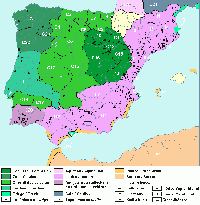
Traditional eighteenth and nineteenth century scholarship surrounding the Celts virtually ignored the Iberian Peninsula, since archaeological material relatable to the Hallstatt and La Tène cultures that have defined Iron Age Celts was rare in Iberia, and did not provide a cultural scenario that could easily be linked to that of Central Europe.
Modern scholarship, however, has proven that Celtic presence and influences were very substantial in Iberia. The Celts in Iberia were divided in two main archaeological and cultural groups, even if the divide is not very clear. One group, from Galicia (Spain) and along the Atlantic shores. They were made up of the Lusitanians (in Portugal and the Celtic region that Strabo called Celtica in the southwest including the Algarve, inhabited by the Celtici), the Vettones and Vacceani peoples (of central west Spain and Portugal), and the Gallaecian, Astures, and Cantabrian peoples of the Castro culture of north and northwest Spain and Portugal.
The Celtiberian group of central Spain and the upper Ebro valley originated when Celts migrated from what is now France and integrated with the local Iberian people.
Celts in Italy
There was an early Celtic presence in northern Italy; inscriptions dated to the sixth century B.C.E. have been found there. In 391 B.C.E. Celts "who had their homes beyond the Alps streamed through the passes in great strength and seized the territory that lay between the Apeninne mountains and the Alps" according to Diodorus Siculus. The Po Valley and the rest of northern Italy (known to the Romans as Cisalpine Gaul) was inhabited by Celtic-speakers who founded cities such as Milan. Later the Roman army was routed at the battle of Allia and Rome was sacked in 390 B.C.E. by Celts.
At the battle of Telemon in 225 B.C.E. a large Celtic army was trapped between two Roman forces and crushed.
The defeat of the combined Samnite, Celtic, and Etruscan alliance by the Romans in the Third Samnite War sounded the beginning of the end of the Celtic domination in mainland Europe, but it was not until 192 B.C.E. that the Roman armies conquered the last remaining independent Celtic kingdoms in Italy.
Celts in other regions
The Celts also expanded down the Danube river and its tributaries. One of the most influential tribes, the Scordisci, had established their capital at Singidunum in third century B.C.E., which is present-day Belgrade. The concentration of hill-forts and cemeteries shows a density of population in the Tisza valley of modern-day Vojvodina, Hungary and into Ukraine. Expansion into Romania was however blocked by the Dacians.
Further south, Celts settled in Thrace (Bulgaria), which they ruled for over a century, and Anatolia, where they settled as the Galatians. Despite their geographical isolation from the rest of the Celtic world, the Galatians maintained their Celtic language for at least seven hundred years. St Jerome, who visited Ancyra (modern-day Ankara) in 373 C.E., likened their language to that of the Treveri of northern Gaul.
The Boii Celtic tribe gave their name to Bohemia (Czech Republic) and Celtic artifacts and cemeteries have been discovered further east in both Poland and Slovakia. A Celtic coin (Biatec) from Bratislava's mint is displayed on today's Slovak 5 crown coin.
As there is no archaeological evidence for large scale invasions in some of the other areas, one current school of thought holds that Celtic language and culture spread to those areas by contact rather than invasion. However, the Celtic invasions of Italy, Greece, and western Anatolia are well documented in Greek and Latin history.[4]
Romanization
The Romans conquered Celtic Gaul, and from Claudius onward the Roman empire absorbed parts of Britain. Roman local government of these regions closely mirrored pre-Roman 'tribal' boundaries, and archaeological finds suggest native involvement in local government. Latin was the official language of these regions after the conquests.
The native peoples under Roman rule became Romanized and keen to adopt Roman ways. Celtic art had already incorporated classical influences, and surviving Gallo-Roman pieces interpret classical subjects or keep faith with old traditions despite a Roman overlay.
The Roman occupation of Gaul, and to a lesser extent of Britain, led to Roman-Celtic syncretism, Roman Britain). In the case of Gaul, this eventually resulted in a language shift from Gaulish to Vulgar Latin.
Culture

Tribal warfare appears to have been a regular feature of Celtic societies. While epic literature depicts this as more of a sport focused on raids and hunting rather than organized territorial conquest, the historical record is more of tribes using warfare to exert political control and harass rivals, for economic advantage, and in some instances to conquer territory.
The Celts were described by classical writers such as Strabo, Livy, Pausanias, and Florus as fighting like "wild beasts," and as hordes. Thus, at least some tribes earned the epithet "barbarian."
In some regards the Atlantic Celts were conservative, for example they still used chariots in combat long after they had been reduced to ceremonial roles by the Greeks and Romans, though when faced with the Romans in Britain, their chariot tactics defeated the invasion attempted by Julius Caesar. However, the Celts were master horsemen, which so impressed the Romans that they adopted Epona, the Celtic horse goddess, into their pantheon.
There are only very limited records from pre-Christian times written in Celtic languages. These are mostly inscriptions in the Roman, and sometimes Greek, alphabets. The Ogham script was mostly used in early Christian times in Ireland and Scotland (but also in Wales and England), and was only used for ceremonial purposes such as inscriptions on gravestones. The available evidence is of a strong oral tradition, such as that preserved by bards in Ireland, and eventually recorded by scribes at Christian monasteries. The oldest recorded rhyming poetry in the world is of Irish origin and is a transcription of a much older epic poem, leading some scholars to claim that the Celts invented Rhyme.
Celtic social system
To the extent that sources are available, they depict a pre-Christian Celtic social structure based formally on class and kinship. Patron-client relationships similar to those of Roman society are also described by Caesar and others in the Gaul of the first century B.C.E.
In the main, the evidence is of tribes being led by kings, although some argue that there is evidence of oligarchical republican forms of government eventually emerging in areas in close contact with Rome. Most descriptions of Celtic societies describe them as being divided into three groups: a warrior aristocracy; an intellectual class including professions such as druid, poet, and jurist; and everyone else. In historical times, the offices of high and low kings in Ireland and Scotland were filled by election under the system of tanistry, which eventually came into conflict with the feudal principle of primogeniture where the succession goes to the first born son.
Little is known of family structure among the Celts. Archaeological discoveries at the Vix Burial indicate that women could achieve high status and power within at least one Celtic society.[5] There are instances recorded where women participated both in warfare and in kingship, although they were in the minority in these areas. Plutarch reports Celtic women acting as ambassadors to avoid a war amongst Celts chiefdoms on the Po valley during the fourth century B.C.E.[6]
As Celtic history was only carried forward by oral tradition, it has been advanced that the traditions finally recorded in the seventh century can be projected back through Celtic history.[7] If this is so then, according to the Cáin Lánamna, a woman had the right to demand divorce, take back whatever property she brought into the marriage and be free to remarry. If later Celtic tradition can be projected back, and from Ireland to Britain and the continent, then Celtic law demanded that children, the elderly, and the developmentally-handicapped be looked after.
Patterns of settlement varied from decentralized to the urban. The popular stereotype of non-urbanized societies settled in hill forts and duns, drawn from Britain and Ireland, contrasts with the urban settlements present in the core Hallstatt and La Tene areas, with the many significant oppida of Gaul late in the first millennium B.C.E., and with the towns of Gallia Cisalpina.
Local trade was largely in the form of barter, but as with most tribal societies they probably had a reciprocal economy in which goods and other services are not exchanged, but are given on the basis of mutual relationships and the obligations of kinship. Low value coinages of potin[8], silver, and bronze, suitable for use in trade, were minted in most Celtic areas of the continent, and in South-East Britain prior to the Roman conquest of these areas.
Celtic smiths and metalworkers created weapons and jewelry for international trade, particularly with the Romans. Celtic traders were also in contact with the Phoenicians: gold works made in pre-Roman Ireland have been unearthed in archaeological digs in Palestine and trade routes between Atlantic societies and Palestine dating back to at least the 1600s B.C.E..
During the later Iron Age the Gauls generally wore long-sleeved shirts of tunics and long trousers. Clothes were made of wool or linen, with some silk being used by the rich. Cloaks were worn in winter. Broaches and armlets were used but the most famous item of jewelery was the torc, a rigid circular neck ring or necklace that is open-ended at the front.
Celtic language
Unfortunately, there are very few written records of the ancient Celtic languages produced by the Celts themselves. Generally these are names on coins and stone inscriptions. Mostly the evidence is of personal names and place names in works by Greek and Roman authors. The date at which the proto-Celtic language split from Indo-European is disputed but may be as early as 6000 B.C.E., with it reaching Britain and Ireland by 3200 B.C.E. In both cases there is a large estimating uncertainty.
Proto-Celtic apparently divided into four sub-families:
- Gaulish and its close relatives, Lepontic, Noric and Galatian. These languages were once spoken in a wide arc from France to Turkey and from Belgium to northern Italy.
- Celtiberian, anciently spoken in the Iberian peninsula, namely in the areas of modern Northern Portugal, and Galicia, Asturias, Cantabria, Aragón and León in Spain.
- Goidelic, including Irish, Scottish Gaelic, and Manx.
- Brythonic (also called Brittonic), including Welsh, Breton, Cornish, Cumbric, the hypothetical Ivernic, and possibly also Pictish.[9][10]
During the first millennium B.C.E., Celtic languages were spoken across Europe, from the Bay of Biscay and the North Sea, up the Rhine and down the Danube to the Black Sea and the Upper Balkan Peninsula, and into Asia Minor (Galatia). Today, Celtic languages are limited to a few areas in Great Britain, the Isle of Man, Ireland, Cape Breton Island, Patagonia, and on the peninsula of Brittany in France.
The Celtic calendar
There were four major festivals in the Celtic Calendar: "Imbolc" on the first of February, possibly linked to the lactation of the ewes and sacred to the Irish Goddess Brigid. "Beltain" on the first of May, connected to fertility and warmth, possibly linked to the Sun God Belenos. "Lughnasa" on the first of August, connected with the harvest and associated with the God Lugh. And finally "Samhain" on the first of November, possibly the start of the year.[11] Two of these festivals, Beltain and Lugnasa are shown on the Coligny Calendar by sigils, and it is not too much of a stretch of the imagination to match the first month on the Calendar (Samonios) to Samhain. Lughnasa does not seem to be shown at all however.[12]
The Celtic Calendar appears to be based on astrology, focusing on passages or cycles of time, rather than a linear progression.[13] It seems to have been based on an indigenous Irish symbol system, and not that of any of the more commonly-known astrological systems such as Western, Chinese or Vedic astrology.[14]
The Coligny Calendar, which was found in 1897 in Coligny, Ain, was engraved on a bronze tablet, preserved in 73 fragments, that originally was 1.48 m wide and 0.9 m high [15]. Based on the style of lettering and the accompanying objects, it probably dates to the end of the second century.[16] It is written in Latin inscriptional capitals, and is in the Gaulish language. The restored tablet contains 16 vertical columns, with 62 months distributed over five years.
The French archaeologist J. Monard speculated that it was recorded by druids wishing to preserve their tradition of timekeeping in a time when the Julian calendar was imposed throughout the Roman Empire. However, the general form of the calendar suggests the public peg calendars (or parapegmata) found throughout the Greek and Roman world.[17]
Celtic religion
Many Celtic gods are known from texts and inscriptions from the Roman period, such as Aquae Sulis, while others have been inferred from place names such as Lugdunum "stronghold of Lug." The Celts did not see their gods as having a human shape until late in the Iron Age. Rites and sacrifices were carried out by priests, some known as Druids. Shrines were situated in remote areas such as hilltops, groves, and lakes.
Celtic religious patterns were regionally variable, however some patterns of deity forms, and ways of worshiping these deities, appear over a wide geographical and temporal range. The Celts worshipped both gods and goddesses. In general, the gods were deities of particular skills, such as the many-skilled Lugh and Dagda, and the goddesses associated with natural features, most particularly rivers, such as Boann, goddess of the River Boyne. This was not universal, however, as Goddesses such as Brighid and The Morrígan were associated with both natural features (holy wells and the River Unius) and skills such as blacksmithing, healing, and warfare.[18]
Triplicities are a common theme in Celtic cosmology and a number of deities were seen as threefold.[18]
The Celts had literally hundreds of deities, some unknown outside of a single family or tribe, while others were popular enough to have a following that crossed boundaries of language and culture. For instance, the Irish god Lugh, associated with storms, lightning, and culture, is seen in a similar form as Lugos in Gaul and Lleu in Wales. Similar patterns are also seen with the Continental Celtic horse goddess Epona, and what may well be her Irish and Welsh counterparts, Macha and Rhiannon, respectively.[18]
Druids fulfilled a variety of roles in Celtic religion, as priests and religious officiants, but also as judges, sacrificers, teachers, and lore-keepers. In general, they were the "college professors" of their time. Druids organized and ran the religious ceremonies, as well as memorizing and teaching the calendar. Though generally quite accurate, the Celtic calendar required manual correction about every 40 years, therefore knowledge of mathematics was required. Other classes of druids performed ceremonial sacrifices of crops and animals for the perceived benefit of the community.[18]
While the regions under Roman rule adopted Christianity along with the rest of the Roman empire, unconquered areas of Scotland and Ireland moved from Celtic polytheism to Celtic Christianity in the fifth century C.E. under missionaries from Britain such as Saint Patrick. Later missionaries from Ireland were a major source of missionary work in Scotland, Saxon parts of Britain, and central Europe. This brought the early medieval renaissance of Celtic art between 390 and 1200 C.E. developing many of the styles now thought of as typically Celtic, and found through much of Ireland and Britain, including the north-east and far north of Scotland, Orkney and Shetland. This was brought to an end by Roman Catholic and Norman influence, though the Celtic languages, as well as some and some influences from Celtic art, continued.
Celtic mythology
In addition to the specifically religious beliefs, Celtic culture also has a rich mythology and understanding of the spiritual world. Numerous mythical creatures were known to the Celts, from the inhabitants of the waters, such as the kelpie, mermaid, and lake monsters such as the world-famous Loch Ness Monster, to the many humanoids—the faeries, pixies, banshees and so forth—some of whom helped and others hindered their human neighbors.
Cult of the severed head
"Amongst the Celts the human head was venerated above all else, since the head was to the Celt the soul, centre of the emotions as well as of life itself, a symbol of divinity and of the powers of the other-world." —Paul Jacobsthal, Early Celtic Art.
The Celtic cult of the severed head is documented not only in the many sculptured representations of severed heads in La Tène carvings, but in the surviving Celtic mythology, which is full of stories of the severed heads of heroes and the saints who carry their decapitated heads, right down to Sir Gawain and the Green Knight, where the Green Knight picks up his own severed head after Gawain has struck it off, just as Saint Denis carried his head to the top of Montmartre. Separated from the mundane body, although still alive, the animated head acquires the ability to see into the mythic realm.
Diodorus Siculus, in his History V, 29, 4- 5; first century B.C.E. had this to say about Celtic head-hunting:
They cut off the heads of enemies slain in battle and attach them to the necks of their horses. The blood-stained spoils they hand over to their attendants and carry off as booty, while striking up a paean and singing a song of victory; and they nail up these first fruits upon their houses, just as do those who lay low wild animals in certain kinds of hunting. They embalm in cedar oil the heads of the most distinguished enemies, and preserve them carefully in a chest, and display them with pride to strangers.
The Celtic headhunters venerated the image of the severed head as a continuing source of spiritual power. If the head is the seat of the soul, possessing the severed head of an enemy, honorably reaped in battle, added prestige to any warrior's reputation. According to tradition the buried head of a god or hero named Bran the Blessed protected Britain from invasion across the English Channel.
Celtic art
The Celts were highly skilled in visual arts and Celtic art produced a great deal of intricate and beautiful metalwork, examples of which have been preserved by their distinctive burial rites. Ancient Celtic artisans recreated many of their sacred animals into metalworks and embroidery. Celtic art is well-known in the forms of intricate Celtic designs, ornamented tools, jewelry, and weapons. Animals, birds, and reptiles interlaced with Celtic knots are known as "zoomorphics."
Ancient Celts took great pride in ornamenting their lives, from ornate necklaces, earrings, and bracelets to the common kitchen utensils and bowls. The nomadic tribespeople of the steppes lovingly adorned their horses with impressive stirrups, and brandished equally impressive weapons with highly decorated handles and straps.
Celtic symbolism plays an integral role in Celtic art forms. As it was often forbidden to make exact replicas of God's work, anthropologists have theorized that the Celts turned to symbols in form of geometry and mathematics, abstraction and exaggeration. Highly detailed knotwork was incorporated to diffuse evil and malignant forces, and the repetition of a particular design was thought to give it more power.
Celtic music
Celtic music may denote Breton or Galician music in addition to Irish, Scottish, and Welsh.
Celtic music has a wistful quality and uses fretted instruments to convey folklore, traditional legends, free-verse, and rhythmic poetry through song format. Some of these instruments are the wire-strung harp, breton harp, Irish harp, indigenous Irish fiddles, the baritone violin, and the Irish banjo. There are also several reed and wind instruments which include the Scottish Lute and the Irish flute, which are incorporated into many traditional and contemporary Celtic songs. An Irish folksong is often referred to as a "bard," and many traveling musicians in the Celtic culture were known as minstrals, singing of tales they learned on the road, spreading both practical news and epic legend through the use of a melody.
Contemporary Celts
At the present time, every aspect of Celtic culture is a very visible part of a multicultural world. Everyone whose family roots lie in central, western, and northwestern Europe has a Celtic connection of some sort.
The English word is modern, attested from 1707 in the writings of Edward Lhuyd whose work, along with that of other late seventeenth century scholars, brought academic attention to the languages and history of these early inhabitants of Great Britain.[19]
In the eighteenth century the interest in "primitivism" which led to the idea of the "noble savage" brought a wave of enthusiasm for all things "Celtic." The antiquarian William Stukeley pictured a race of "Ancient Britons" putting up the "Temples of the Ancient Celts" such as Stonehenge before he decided in 1733 to recast the Celts in his book as Druids. The Ossian fables written by James Macpherson and portrayed as ancient Scottish Gaelic language poems added to this romantic enthusiasm. The "Irish revival" came after the Catholic Emancipation Act of 1829 as a conscious attempt to demonstrate an Irish national identity, and with its counterpart in other countries subsequently became the "Celtic revival".[20]
Celtic culture is very ancient, yet it is still a living force in the modern world, through Celtic art, Celtic music, Celtic writing, and Celtic spirituality. The civilization of the Celts has continued without break over the centuries. This tradition can be experienced in the oldest literature from Northern Europe, that is, in the Welsh and Irish languages. The earliest Welsh and Irish writings preserve the ancient Celtic world-view that is nature-venerating and poetic, where the spiritual and the material worlds come together to enrich one another.
Throughout history, the Celtic tradition and belief has not remained stagnant, but has progressively evolved and continued in keeping up with the times. In olden days, the early beliefs of the Celts were taken over and reformed by the Druids, who in turn were influenced by Roman religion. In time, this was transformed by Christianity in the form of the Celtic Church. This was not a break with tradition, but a continuation of the Celtic essence in a new form.
The Celts were great warriors, living clannishly for centuries, but they were also deep thinkers. They were mathematicians, artisans, astronomers, musicians, and scientists, and the legacy of the Celtic people is carried on today. Tourists from all around the globe flock to the emerald isles of Ireland and Scotland seeking out the mystical, drawn towards the mysteries of the Brittanic peoples known as the Celts.
Any music company that specializes in both Irish and Scottish records as well as Canadian folk music and northern English music, all of which have similar repertoires of jigs, reels, airs, and folksongs, can claim to specialize in Celtic music. Celtic music is a vast collection of many different regions and subregions of medieval Europe, and as such, belongs to the entire world. The existence of "Celtic" music is thus a result of the commodification and marketing of certain musical forms.
Brittany is a world leader in developing one of the largest and most successful recording industries in the world, which ensures that music of all genres, including Gaelic and Celtic music both traditional and contemporary, becomes released in mass distribution. The widespread collection of folk music has been revamped by a new generation of musicians, and remade with a modern sound. This is why the revitalization of Celtic music has been such an impacting force in ethnic world music, and made such an international comeback.
Many Celtic songs are played on modern acoustic guitars, tuned to the open DADGAD tuning, which is a popular alternative to the standard EADGBE tuning of the strings, which lends Celtic songs their unique sound.
Notable Celts
Women
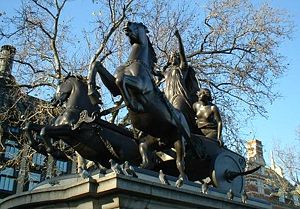
- Cartimandua, (or Cartismandua, ruled ca. 43 B.C.E. - 69 B.C.E.), was a queen of the Brigante], a Celtic tribe that lived between the rivers Tyne and Humber, that formed a large tribal agglomeration in northern England. She was the only queen in early Roman Britain, identified as regina by Tacitus.
- Camma, priestess of Brigandu, wife of Sinatos.
- Boudica, (also spelled Boudicca), and often referred to as Boadicea, outside academic circles, (d. 60/61 B.C.E.) was a queen of the Brythonic Celtic Iceni people of Norfolk in Eastern Roman Britain who led a major but ultimately failed uprising of the tribes against the occupying forces of the Roman Empire. (See Battle of Watling Street)
- Scáthach (Shadowy), a legendary Scottish warrior woman and martial arts teacher who trained the legendary Ulster hero Cúchulainn in the arts of combat. Texts describe her homeland as "Alpi," which commentators associate with Alba, the Gaelic name of Scotland, and associated with the Isle of Skye, where her residence Dún Scáith (Fort of Shadows) stands.
Celtic Men
- Bolgios Leader of the Galatii in Macedonia.
- Brennus Leader of the Celts who sacked Rome.
- Cassivellaunus Leader of Britons against Julius Caesar.
- Commius Leader of the Belgae who settled in Britain.
- Cunobelinus Leader of the Catuvellauni against Claudius.
- Vercingetorix Led revolt in Gaul against Julius Caesar.
- Verica Leader of the Atrebates whose flight to Rome was the pretext for the invasion of Britain.
Notes
- ↑ Haplogroup R1b (Atlantic Modal Haplotype) Retrieved August 20, 2007.
- ↑ Geneticists find Celtic links to Spain and Portugal breakingnews.ie. Retrieved August 20, 2007.
- ↑ A Y Chromosome Census of the British Isles familytreedna.com. Retrieved August 20, 2007.
- ↑ Map of Celtic Lands resourcesforhistory.com Retrieved December 5, 2005.
- ↑ the Vix Burial
- ↑ Peter Berresford Ellis. The Celts: A History. (Caroll & Graf, 1998. ISBN 0786712112).
- ↑ Donnchadh O Corrain. Celtic Ireland. (Academy Press, 1981).
- ↑ Marc Breitsprecher, "A Brief Introduction to Celtic Potins of Gaul." [1]ancientimports.com. Retrieved October 8, 2008.
- ↑ Katherine Forsyth, 1997. Language in Pictland : the case against 'non-Indo-European Pictish Retrieved August 22, 2007.
- ↑ James & Taylor, "Index of Celtic and Other Elements" in W.J. Watsons, The History of the Celtic Place-names of Scotland
- ↑ Simon James. Exploring the World of the Celts. (2002).
- ↑ The Coligny Calendar Roman-Britain.org. (2001). Retrieved August 20, 2007.
- ↑ Celtic Astrologylivingmyths.com. Retrieved August 22, 2007.
- ↑ Peter Berresford Ellis, "Early Irish Astrology: An Historical Argument", Réalta 3 (3) (1996). Retrieved August 22, 2007.
- ↑ Pierre-Yves Lambert. La langue gauloise. (Paris: Editions Errance, 2003. ISBN 2877722244), 111
- ↑ Lambert
- ↑ D. R. Lehoux, (PhD Dissertation, University of Toronto, 2000). Parapegmata: or Astrology, Weather, and Calendars in the Ancient World collectionscanada.ca. Retrieved August 22, 2007.
- ↑ 18.0 18.1 18.2 18.3 Marie-Louise Sjoestedt. Gods and Heroes of the Celts, Translated by Myles Dillon (Berkeley, CA: Turtle Island Foundation, 1982. ISBN 0913666521)
- ↑ E. Lhuyd. Archaeologia Britannica; An account of the languages, histories, and customs of the original inhabitants of Great Britain. (Irish University Press, 1971. ISBN 0716500310).
- ↑ Lloyd and Jenifer Laing. Art of the Celts. (London: Thames and Hudson, 1992. ISBN 0500202567).
ReferencesISBN links support NWE through referral fees
- Alberro, Manuel and Bettina Arnold (eds.). 2005. "Volume 6: The Celts in the Iberian Peninsula." in e-Keltoi: Journal of Interdisciplinary Celtic Studies. Milwaukee: University of Wisconsin Center for Celtic Studies. Retrieved August 20, 2007.
- Bailey, Leathanach. "What is Celtic Music," The Standing Stones. Retrieved August 15, 2007.
- Collis, John. 2003. The Celts: Origins, Myths and Inventions. Stroud, UK: Tempus Publishing. ISBN 0752429132.
- Cunliffe, Barry. 1997. The Ancient Celts. Oxford: Oxford University Press. ISBN 0198150105.
- Cunliffe, Barry. 2004. Iron Age Britain. London: Batsford. ISBN 0713488395
- Cunliffe, Barry. 2003. The Celts: A Very Short Introduction.
- Ellis, Peter Berresford. The Celts: A History. Caroll & Graf, 1998. ISBN 0786712112
- del Giorgio, J.F. 2006. The Oldest Europeans: Who are we? Where do we come from? What made European women different?. A.J. Place. ISBN 9806898001
- Forsyth, Katherine. 1997. Language in Pictland : the case against 'non-Indo-European Pictish Retrieved August 22, 2007.</ref>
- Green, Miranda. 1998. Celtic Goddesses: Warriors, Virgins and Mothers. British Museum Press. George Braziller, 1996. ISBN 080761405X
- Haywood, John. Atlas of the Celtic World. Thames & Hudson, 2001. ISBN 0500051097
- Jacobsthal, Paul. Early Celtic Art. London: The Clarendon Press, 1944. ASIN: B0014MVRX2
- James, Simon. 1993. Exploring the World of the Celts.
- James, Simon. 1999. The Atlantic Celts - Ancient People Or Modern Invention? Madison: University of Wisconsin Press. ISBN 0299166740.
- James, Simon. The World of the Celts. Thames & Hudson, 2005. ISBN 0500279985
- James, Simon & Valerie Rigby. 1997. Britain and the Celtic Iron Age. London: British Museum Press. ISBN 0714123064.
- Konstam, Angus. Historical Atlas of the Celtic World. Mercury Books, 2004. ISBN 1904668011
- Kruta, V., O. Frey, Barry Raftery and M. Szabo. eds. 1991. The Celts. New York: Thames & Hudson. ISBN 0847821935. (A translation of Les Celtes: Histoire et Dictionnaire 2000.)
- Laing, Lloyd. 1975. The Archaeology of Late Celtic Britain and Ireland c. 400–1200 C.E. London: Methuen. ISBN 0416823602
- Laing, Lloyd and Jenifer Laing. 1992. Art of the Celts. London: Thames and Hudson. ISBN 0500202567
- Lambert, Pierre-Yves. La langue gauloise. Paris: Editions Errance, 2003. ISBN 2877722244
- Lhuyd, E. Archaeologia Britannica; An account of the languages, histories, and customs of the original inhabitants of Great Britain. Irish University Press, 1971. ISBN 0716500310
- MacKillop, James. 1998. A Dictionary of Celtic Mythology. Oxford: Oxford University Press. ISBN 0192801201
- Mallory, J. P. 1991. In Search of the Indo-Europeans: Language, Archaeology and Myth. London: Thames and Hudson. ISBN 0500276161.
- McEvedy, Colin. 1985. The Penguin Atlas of Ancient History. New York: Penguin. ISBN 0140708324
- Morse, Michael. How the Celts came to Britain.
- Oppenheimer Stephen. The Origins of the British.
- O Corrain, Donnchadh. Celtic Ireland. Academy Press, 1981.
- o'Rahilly, T. F. 1946. Early Irish History. Dublin Institute for Advanced Studies.
- Powell, T. G. E. 1997. The Celts. New York: Thames and Hudson. ISBN 0500272751.
- Raftery, Barry. 1994. Pagan Celtic Ireland: The Enigma of the Irish Iron Age. London: Thames & Hudson. ISBN 0500279837.
- Renfrew, Colin. 1990. Archaeology and Language: The Puzzle of Indo-European Origins. Cambridge: Cambridge University Press. ISBN 0521386756.
- Sjoestedt, Marie-Louise. Gods and Heroes of the Celts, Translated by Myles Dillon. Berkeley, CA: Turtle Island Foundation, 1982. ISBN 0913666521
- Sykes, Bryan. 2006. Blood of the Isles: Exploring the Genetic Roots of our Tribal History. London: Bantam. ISBN 0593056523
External links
All links retrieved December 3, 2023.
- The Celts with Barry Cunliffe on BBC Radio 4's In Our Time, February 21, 2002.
- "English and Welsh are races apart" BBC.
- Y Chromosome Evidence for Anglo-Saxon Mass Migration
Credits
New World Encyclopedia writers and editors rewrote and completed the Wikipedia article in accordance with New World Encyclopedia standards. This article abides by terms of the Creative Commons CC-by-sa 3.0 License (CC-by-sa), which may be used and disseminated with proper attribution. Credit is due under the terms of this license that can reference both the New World Encyclopedia contributors and the selfless volunteer contributors of the Wikimedia Foundation. To cite this article click here for a list of acceptable citing formats.The history of earlier contributions by wikipedians is accessible to researchers here:
The history of this article since it was imported to New World Encyclopedia:
Note: Some restrictions may apply to use of individual images which are separately licensed.
